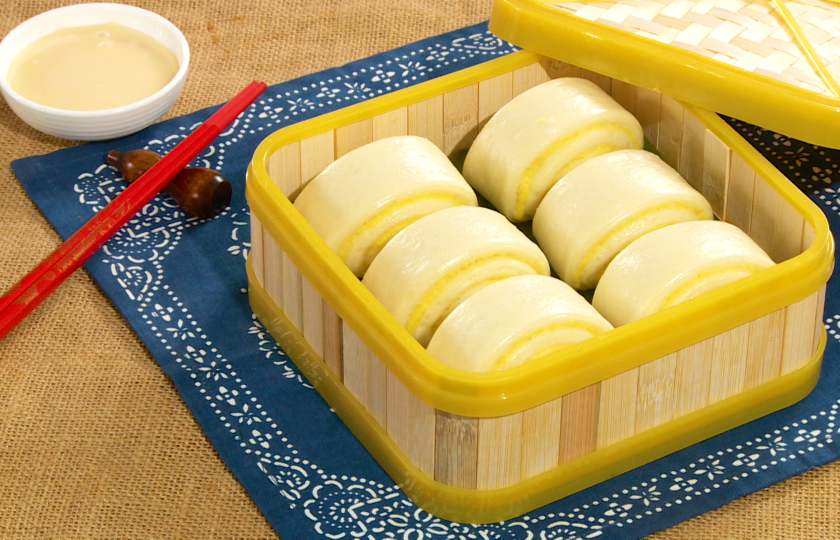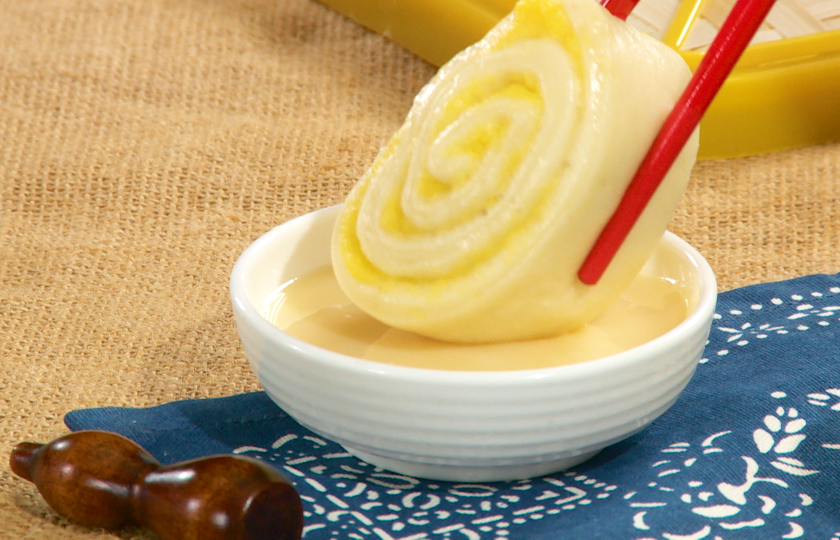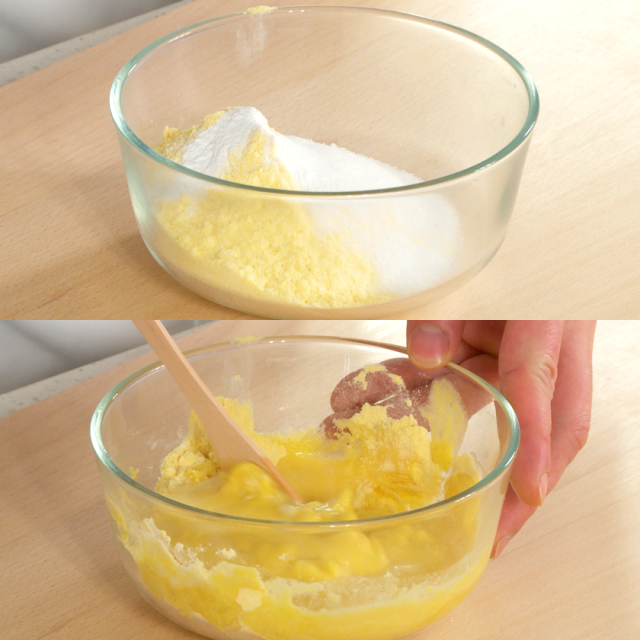Two-Tone Flour Rolls(双色卷)


Steaming two-color rolls is a cooking art that requires patience. From stirring the batter to the final rolling, every step needs careful control to present a perfect effect.
What are two-color rolls
Two-color rolls are a kind of pasta that combines two ingredients, cornmeal and flour, with excellent color and taste.
Its production is unique. First, carefully mix 100 grams of cornmeal, sugar, and baking powder, and add water to stir into a cornmeal dough. On the other side, prepare yeast water. Then, mix 500 grams of flour, sugar, and baking powder with yeast water and clear water, and knead out a white dough. Then evenly spread the cornmeal dough on the rolled out white pancake, roll it up, cut it into sections, and steam it in a steamer.
The finished product has extremely high appearance value. The yellow and white spiral pattern is eye-catching. The outer white surface is soft and glutinous, and the inner cornmeal is sweet. The taste is soft and layered. Eating is also casual. It is suitable for breakfast and afternoon tea. You can eat it alone to taste the original flavor. Dip it in sauces such as chili sauce and peanut butter, and the taste is even richer. It is extremely delicious when eaten hot. When it cools down, heat it slightly in a microwave oven, and it is still delicious.
Ingredients and substitutes
To make this two-color roll, you need to prepare the following materials:
Main ingredients
Cornmeal: Rich in dietary fiber, it adds a unique corn aroma and color to the two-color roll.
Flour: It is the main raw material for making dough and makes the finished product soft in taste.
Accessories
Yeast powder: Used for fermenting dough to make the two-color roll more fluffy.
Seasonings
Sugar: Increases sweetness and enhances the taste.
Baking powder: Assists fermentation and makes the dough easier to expand and the finished product softer in taste.
Substitutes
If there is no cornmeal, other coarse grain flours such as millet flour can be used instead, but the flavor will change.
For yeast powder, high-sugar-tolerant yeast powder can be selected. Especially when a large amount of sugar is used, the fermentation effect is better. If there is no yeast powder, old dough can also be tried to replace it, but old dough needs to be prepared in advance and the fermentation time will be different.
Sugar can be replaced with brown sugar, which will give the two-color roll a unique brown sugar aroma and color, but the sweetness and flavor are slightly different.
For baking powder, aluminum-free baking powder can be chosen for better health. If you don't want to use baking powder, you can appropriately increase the amount of yeast powder and extend the fermentation time to achieve a similar effect.

What are the techniques for kneading the white dough
Preparing the cutting board: First, sprinkle an appropriate amount of flour on the cutting board, about 30 grams. Flour can prevent the dough from sticking to the cutting board and facilitate the smooth progress of the subsequent kneading actions, making the dough evenly stressed.
Kneading strength and technique: Both hands should apply force evenly. Press the dough with the base of the palm, push and knead forward, and then fold it back. Repeat this action continuously. The strength should be moderate. If it is too light, it is difficult to knead the dough until it is smooth. If it is too heavy, it will damage the gluten and affect the toughness of the dough. Knead for 5-10 minutes until the surface of the dough is smooth and the internal structure is fine and uniform.
Perceiving the state of the dough: When kneading, feel the softness and hardness of the dough with your hands. If it is too hard, you can dip a little clear water and continue kneading. If it is too soft, sprinkle a small amount of flour to assist. Adjust the state of the dough at any time to ensure that the dough is easy to operate and does not crack when rolling out pancakes later.
How to adjust if the cornmeal dough is too thin
Just two simple steps can bring it back to the effect you want.
First step, add an appropriate amount of flour. If the dough is too thin, the root cause is excessive moisture. At this time, adding cornmeal is the remedy. Just sprinkle 5 - 10 grams of cornmeal into the thin dough each time. After sprinkling, quickly stir evenly with chopsticks or a spatula immediately to make the newly added flour evenly blend into the dough. During the process, you have to keep an eye on the state of the dough at all times to ensure that it absorbs the excess moisture without dry powder or lumps until an appropriate consistency is adjusted.
Second step, let it stand and evaporate. Put the thin dough in a well-ventilated place and let it stand quietly for 10 - 15 minutes to let part of the moisture in the dough evaporate naturally. But be more careful. Dont exceed the time. Otherwise, if the surface of the dough cracks and the whole becomes dry, it cant be used.
What's the reason if the finished product is too hard
Reason one: Insufficient moisture
When preparing the cornmeal dough and white dough, not controlling the amount of water well is the key reason for the two-color roll to become hard. For example, when making white dough, if 260 grams of clear water should be added but less is added. The same is true for cornmeal dough. If there is not enough moisture, the dough will be dry and lose its flexibility. During steaming, it cannot puff up, and the finished product will definitely be hard.
Solution: Carefully check the recipe before making and measure the water accurately with a measuring cup. Pay more attention to the softness and hardness of the dough when kneading. If it is found to be dry, add 5-10 ml of water in small amounts several times while stirring and kneading. Knead until the dough is soft and not sticky. Remember to observe the humidity of the dough every time you make it in the future.
Reason two: Oversteaming
If the steaming time of the two-color roll is exceeded, it will also become hard. Normally, it is steamed on high heat until boiling and then turned to low heat for 10 minutes. If there is no timing and it is steamed for too long, steam will keep coming out. The moisture in the two-color roll will be steamed dry, and the original soft structure will be gone, and the taste will be dry and hard.
Solution: Prepare a kitchen timer. Start timing when turning to low heat. Turn off the fire immediately when the time is up. Don't keep opening the lid to look. After turning off the fire, simmer for 2-3 minutes. Use the residual heat to make the two-color roll fully cooked and also keep the moisture and maintain softness.
Reason three: Wrong flour selection
Using the wrong high-gluten flour will make the two-color roll easily hard. High-gluten flour has more gluten and strong toughness. The dough cannot expand during steaming and is tightly wrapped by gluten. The finished product is compact and has a bad taste.
Solution: Replace it with medium-gluten flour. Its gluten content is appropriate, and the softness of making two-color rolls is just right. If there is only high-gluten flour, mix it with corn starch in a ratio of 20%-30% and stir well before kneading to reduce the gluten strength and make the two-color roll softer.
INGREDIENTS
Main Ingredients
-
·100g cornmeal
-
·530g flour
Additional Ingredients
-
·5g yeast powder
Seasonings
-
·35g sugar
-
·5g baking powder
Table of Contents
- ·What are two-color rolls
- ·Ingredients and substitutes
- ·What are the techniques for kneading the white dough
- ·How to adjust if the cornmeal dough is too thin
- ·What's the reason if the finished product is too hard
- ·Ingredients
- ·Cooking step
- ·More recipes worth trying
- ·Recipe Variations
- ·Storage instructions
- ·FAQs
COOKING STEP
Step 1
Pour 100g cornmeal, 25g sugar and 1g baking powder into a container. Then add 50ml clear water in multiple times. After adding a small amount of clear water each time, stir continuously until a relatively thick cornmeal dough is formed and set aside.

Step 2
Take another container, put 5g yeast powder in it, then add 50ml warm water and stir with chopsticks to fully dissolve the yeast powder in the warm water. After making yeast water, set it aside.

Step 3
Put 500g flour, 10g sugar and 4g baking powder in a large bowl in turn. Then pour in the previously prepared yeast water and add 260g clear water. Stir evenly with tools such as chopsticks to form a dough.

Step 4
Sprinkle 30g flour on the cutting board. Place the white dough on the cutting board and knead it with hands. Knead for 5-10 minutes until the surface of the dough becomes smooth and the internal structure is uniform. After that, roll the dough into a thin pancake with a thickness of about 0.5 centimeters with a rolling pin.

Step 5
Evenly spread the previously made cornmeal dough on the rolled thin pancake with tools such as a spatula. Then start rolling from the edge of the pancake. Roll it tightly. After rolling, cut it into small sections about 3 centimeters wide with a knife.

Step 6
Put the cut small sections into the steamer in turn. Note that a certain distance should be left between the small sections to prevent adhesion. After putting them in place, cover the lid. First boil the water on high heat, and then turn to low heat and steam for 10 minutes.

Step 7
After the two-color rolls are cooked, take off the steamer and use clips to take out the two-color rolls. They can be eaten with your favorite dipping sauce.

More recipes worth trying
Exquisite Creative Chinese White Radish Recipe
Delicious Steamed Crucian Carp Recipe
Rolling Donkey: A Beijing Snack with Cultural Charm
Traditional Hakka Tea Cake Recipe
Recipe Variations
Innovative fillings: Evenly spread 50-80g of red bean paste on the white pancake. The sweet, smooth and glutinous taste meets the two-color noodles, creating an indescribably wonderful flavor. Or sprinkle 40-60g of meat floss. The salty and fragrant aroma lingers, catering to the preferences of those who like salty tastes. Every bite is super filling.
Diverse seasonings: Mix 5-8g of milk powder into the cornmeal. The milk fragrance combines with the corn fragrance, resulting in a rich and mellow taste. Add 3-5ml of lemon juice to the white dough to easily remove the fishy smell. The fruity aroma overflows, giving the two-color roll a fresh taste.
Variable shapes: Twist the rolled noodle roll into a 5-8 centimeter long twist shape, unique and eye-catching. Or coil it into a spiral bun shape, as delicate as a work of art. It becomes the focus instantly when served, adding a lot of fun to the dining table.
Mixed ingredients: Knead 30-50g of purple sweet potato puree into the cornmeal dough. The color is bright and charming. Add 20-30g of oatmeal to the white dough, which is full of dietary fiber. The taste is slightly rough but healthy.
Storage instructions
Seal the two-color rolls with fresh-keeping bags or fresh-keeping boxes and put them in the refrigerator's cold storage compartment. It can retain moisture. There is no problem for them to be stored for 2-3 days. But the sooner you eat them, the better. After a long time, pasta is easy to become dry and hard, and bacteria will also breed quietly.
Before eating, you can heat it in a microwave oven for 30 seconds or steam it in a steamer for 2 minutes when the steam rises, and it can restore its softness. Especially in summer, pay attention. In hot weather, food spoils quickly.
FAQs:
Second, with the help of water: If it is really difficult to connect well, flatten the broken part again, dip a little clear water at the break, and use the stickiness produced by the dough when it meets water to help it reconnect. The application of the cornmeal dough should be uniform. Too thick or too thin is easy to break during rolling. The movements should also be quick and not sluggish or paused.
Even if the pattern of the two-color roll after remediation is not so regular, it will not affect the deliciousness after being steamed. In future operations, remember to roll the dough thinner and make the cornmeal evenly distributed, so as to reduce the trouble of breaking.
Furthermore, use cling film or a fresh-keeping bag: Put the dough in the middle of the two. When rolling, move it according to the change of the dough so that it does not directly touch the cutting board. In this way, there will be no problem of adhesion.
There is also applying cooking oil: Dip a small amount of oil with a clean cloth and spread it evenly on the cutting board to create a thin oil film. Then rolling the dough will be much smoother. However, you have to control the amount. If there is too much oil, the dough will have an oily smell and affect the flavor.
You can also try to change the filling. Prepare 80-100 grams of minced meat, season it with an appropriate amount of light soy sauce, cooking wine, salt, and pepper, then stir-fry it and spread it on the pancake before rolling. The salty two-color roll after being cooked is soft and salty. It is an excellent choice for those who like salty tastes.
It is not recommended to defrost directly with a microwave oven, as it is easy to make the dough become hard and tough. If you must use a microwave oven, remember to wrap it with plastic wrap, choose low-power heating, and turn it over halfway. This way, the heating is relatively uniform. The taste of the defrosted two-color roll may be a bit worse, but it is still very delicious when eaten while it is hot.

















